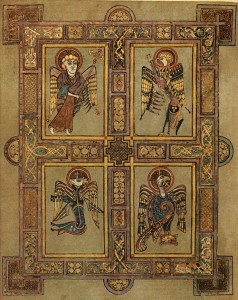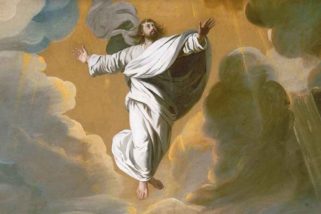When were the gospels written? With their absence in Justin Martyr’s works, we remain with the dating of the gospels to the last quarter of the second century.
By Acharya S/D.M Murdock
The Gospel Dates
When scrutinized, the Pauline epistles do not reveal any historical Jesus; nor do they demonstrate any knowledge of the existence of the four canonical gospels, Matthew, Mark, Luke and John. As has been proved repeatedly, the gospels themselves cannot be viewed as “history” written by “eyewitnesses.” Besides the fact that they date to much later than is supposed, the gospels frequently contradict each other, and, based on the numerous manuscripts composed over the centuries, have been determined (by German theologian Johann Griesbach, for one) to be a mass of some 150,000 “variant readings.” In this regard, The Interpreter’s Dictionary of the Bible, a Christian book, contains an article written by M.M. Parvis (vol. 4, 594-595), who states:
The New Testament is now known, in whole or in part, in nearly five thousand Greek manuscripts alone. Every one of these handwritten copies differ from the other one It has been estimated that these manuscripts and quotations differ among themselves between 150,000 and 250,000 times. The actual figure is, perhaps, much higher. A study of 150 Greek manuscripts of the Gospel of Luke has revealed more than 30,000 different readings It is safe to say that there is not one sentence in the New Testament in which the manuscripts’ tradition is wholly uniform.
Some sources place the figure for the “variant readings” even higher, including The Anchor Bible Dictionary On CD-ROM (“Textual Criticism, NT”), which says, “Perhaps 300,000 differing readings is a fair figure for the 20th century (K.W. Clark 1962: 669).” So much for “God’s infallible Word” and his “inspired scribes.” Apologists have come up with all sorts of excuses for this manmade mess; their excuses only demonstrate further that man’s hand – and not that of the Almighty God – has been involved in the creation of Christianity and its texts at every step.
It would be impossible to date the appearance of the gospels based on the extant manuscripts, since the autographs or originals were destroyed long ago, an act that would appear to be the epitome of blasphemy, were these texts truly the precious testimonials by the Lord’s very disciples themselves. Although a miniscule bit of papyrus (Rylands P52) dating to the middle of the second century has been identified speculatively as part of “John’s Gospel” (18:31-33), the oldest fragments conclusively demonstrated as coming from the canonical gospels date to the 3rd century. The two verses of “John’s Gospel,” comprising only about 60 words, could easily be part of another, non-canonical gospel, of which there were numerous in the first centuries of the Christian era. That such texts contained verses paralleling those found in the canonical gospels is known from the writings of Justin Martyr, for example, who quotes from a number of them.
In reality, the four gospels selected for inclusion in the New Testament do not make any appearance in the literary and archaeological record until the last quarter of the 2nd century,between 170 and 180 CE, and even then they are not much mentioned for a couple of decades. In this regard, Church father and archbishop of Constantinople John Chrysostom (c. 347-407) stated that the names traditionally attached to the canonical gospels were first designated at the end of the second century. The orthodox dating, of course, attempts to put the gospels a century earlier, between 70 and 110 CE. However, it should be kept in mind that the current mainstream dating was heretical when first propagated, over 150 years ago, causing apoplexy in the faithful, who believed the texts were composed shortly after Jesus’s death. Over the centuries, because of increasingly scientific scholarship, the date of the canonical gospels has been continually pushed to later decades, as it has long been accepted that there is absolutely no evidence, internal or external, for such an early date.
The early dating is mere wishful thinking on the part of those who truly believe that Jesus Christ existed and that his words, deed and life were faithfully recorded by eyewitnesses, i.e., his disciples. Such a scenario is not reality, however, and the most scholarship can offer in bending the dates to fit the alleged adventof Jesus Christ in the time of Herod is that the gospels were composed during the last decades of the first century. The internal evidence cited for this “late” a date is that the gospel writers were aware of the destruction of Jerusalem in 70 CE. Therefore, Mark, considered by most mainstream authorities to be the earliest of the gospels, could not have been written anyearlier than 70 CE. The others followed, with John appearing perhaps as late as 110 CE. That is where mainstream scholarship ends. Nonetheless, the fact remains that the gospels are conspicuously absent from the writings of the Church fathers and apologists until the end of the second century.
As concerns the order in which the gospels were written, the priority of Mark was proposed as early as 1786 by Storr and argued in detail by Christian Wilke in 1838. According to proponents of the specious “outdated” argument, which claims that newer scholarship is better and more correct merely by virtue of its “modernity,” the Markan—priority thesis is a very “outdated” premise and must therefore be wrong. By this same argument, “Q” scholarship—which proposes that an original “sayings” text was used in the creation of the gospels – is likewise “outdated,” because it too began over a century and a half ago, with the research of Christian Weiss, also in 1838. It should be noted that even the existence of a Q document has been argued against by a number of scholars, including Farrer (1955), Farmer (1964) and Hobbs (1980).
Despite these facts, it is perceived that to go against the crowd is to commit scholarly heresy! In actuality, critics of the Mark-priority thesis must come afterwards, obviously, which makes their theories more “modern.” G.R.S. Mead, for one, writing after the Markan-priority thesis was proposed, was insistent that the other synoptists, Matthew and Luke, did not use the canonical Mark as one of their source texts: “It is very evident that Mt. and Lk. do not use our Mk., though they use most of the material contained in our Mk.”
This conclusion was also reached by Helmut Koester and others in the modern era. Indeed, scholars have hit upon an “Ur-Markus” or source of Mark from which all three synoptics (Matthew, Mark and Luke ) drew. Hence, it is asserted by Ur-Markus proponents that the other two synoptics did not use the canonical Mark. The Ur-Markus theory was developed by Weisse in the 1850s. At the end of the 19th century, Hernle attempted to prove that Ur-Markus was the canonical Mark, and the debate was supposedly settled in the 1920s. Yet, modern mainstream scholars continue to debate the priority. As Burton Mack says, in The Lost Gospel of Q, “Even today there are scholars who continueto favor Matthew as the earliest gospel.”
Following Griesbach (1783), the Tubingen School in the 1830s maintained not only the priority but also the late date of 130 CE for Matthew, swimming firmly against the tide. Scholars of the 20th century who have argued for the priority of Matthew include “Jameson, Chapman, Butler, and Wenham.”
The fact is that scholars have gone back and forth on the order, as did the early Church fathers. As the Catholic Encyclopedia relates (“Synoptics”):
The order: Matthew, Luke, Mark, was advanced by Griesbach and has been adopted by De Wette, Bleek, Maier, Langen, Grimm, Pasquier. The arrangement: Mark, Matthew, Luke, with various modifications as to their interdependence, is admitted by Ritschl, Reuss, Meyer, Wilke, Simons, Holtzmann, Weiss, Batiffol, Weizscker, etc. It is often designated under the name of the “Mark hypothesis”, although in the eyes of most of its defenders, it is no longer a hypothesis, meaning thereby that it is an established fact. Besides these principal orders, others (Mark, Luke, Matthew; Luke, Matthew, Mark; Luke, Mark, Matthew) have been proposed, and more recent combinations (such as those advocated by Calmel, Zahn, Belser, and Bonaccorsi) have also been suggested.
In Therapeutae: St. John Never in Asia Minor, George Reber evinces that the order the gospels were composed is the same as their placement in the canon: Matthew, Mark, Luke and John, as each one appears to correct the previous texts’ mistakes, likely pointed out by critics along the way. Says Reber, “The blunders and mistakes of the first Gospel [Matthew] made it necessary that there should be a second.” Reber further states, “Mark copies Matthew, and Luke uses the words of both.” Concerning the gospel of Matthew, Reber also remarks that the book”the source of all”was “not written in Judea, or by one who knew anything of geography of the country, or the history of the Jews.” “Whoever the writer may have been,” he continues, “it is evident that he received his education at the college at Alexandria, where Medicine and Divinity were taught, and regarded as inseparable.”
Despite claims to the contrary, little in New Testament scholarship is set in stone, including not only the priority of the gospels but also the dating. In reality, the majority of modern bible scholars have simply gone along with the dates of c. 70-110 CE, in spite of the fact that there is no evidence of the gospels’ existence until a century later, as evinced by such notables as Bronson Keeler, author of A Short History of the Bible; the Christian Judge Charles Waite in History of the Christian Religion to the Year Two Hundred; and Walter Cassels in Supernatural Religion. Cassels’s knowledge on the subject was so startlingly profound that, when his book was first released anonymously, other scholars—including Christian detractors—believed him to be a bishop. Regarding the orthodox dates (70-110), which were already established by his time at the end of the 19th century, Cassels states, “It is evident that the dates assigned by apologists are wholly arbitrary.”
Justin Martyr (c. 100-c. 165-167)
Although a number of writers and apologists have argued that Justin Martyr is the first Christian writer to be cognizant of the canonical gospels, in reality Martyr does not quote from the New Testament texts but apparently uses one or more of the same sources employed in the creation of the gospels, as well as other texts long lost. Furthermore, no other writer subsequent to Martyr shows any awareness of the existence of the gospels until around the year 180. It should also be noted that Martyr ‘s works did not escape the centuries of mutilation and massive interpolation done to virtually every ancient author’s works,which makes the disentanglement all that more difficult. Yet, even as it stands, Justin’s writing still does not demonstrate knowledge of the canonical gospels.
In dozens of pages, Cassels provides a painstaking and thorough analysis of the Martyr material, using the original Greek text and revealing that Justin often repeats the same quotes, making it appear as if he is quoting “extensively,” when, in fact, as the material is pared down, very little is left germane to the quest of whether or not the canonical gospels existed in his time. In the end, there is a mere handful of Martyr ‘s sentences that Christian authorities have attempted to hold up as evidence for the gospels’ existence: For example, biblical scholar Tischendorf “only cites two passages in support of his affirmation that Justin makes use of our first Gospel.”
A number of the passages in Justin that purportedly correspond to New Testament scriptures come from a text called “Memoirs of the Apostles,” which, Cassels shows, is a book by that title, not a reference to several “memoirs” or apostolic gospels. The “Memoirs,” in other words,” constitutes a single textlike the “Acts of the Apostles.” Upon examination, the quotes Justin uses from the Memoirs “differ more or less widely” from parallel scriptures in the synoptics, Matthew, Mark and Luke. As confirmed by Tischendorf, only a couple of short exceptions are sufficiently similar to warrant comparison with the synoptic gospels. These various passages from the Memoirs or “Memorabilia” are repeated often enough that it is clear Justin is quoting them verbatim, rather than paraphrasing; yet, they are not identical to gospel scriptures, differing enough that they could not have come from those books. “There is almost invariably some difference,” says Keeler “either in sense or construction, showing that Justin’s book was different from our Gospels.” Also, several of the Memoirs scriptures do not appear in any form in the canonical gospels. Moreover, Justin ‘s version of the gospel tale and the Church history in its details is different from and contradictory to that found in the New Testament.
Per the extant archaeological evidence and literary record, the gospel story itself does not even make its appearance in detail until the time of Justin around 140-150 CE. Even so, it is evident that Martyr did not refer to the four gospels. Nor did he address the apostles as we know them from the New Testament tales, which is peculiar considering that Justin opposed the Docetist Marcion, whose Gospel of the Lord was also “Paul’s gospel” although not the “veiled gospel” of the Pauline epistles. Oddly enough, particularly since he does attack Marcion, who considered Paul the “truest apostle,” Justin never refers to Paul. Also, despite his illusion to the Gospel of Peter, Martyr depicts virtually nothing of the chief apostle. Indeed, Reber remarks that Justin is “so oblivious of Peter that he seems to have been unconscious of his existence.” Concerning these important developments, Johnson remarks that the “Memorabilia do not coincide on their contents as a whole with any work that has come down to us; nor are the Apostles’ identifiable with any known historical person.” He then explains that the term “apostle” is Jewish and pre-Christian, referring to wandering Jews of the Diaspora (Jewish dispersion throughout the Roman Empire), and that the Memorabilia may simply be their “moral sayings.”
In addition, rather than being sloppy in his citations, which is the accusation made to explain why his “Memoirs ” differs somuch from the gospels, Justin is surprisingly consistent and conscientious in his quotation. For example, Martyr quotes from the Old Testament 314 instances, 197 of which he names the particular book or author, equaling an impressive two-thirds of the total amount. Several of the other 117 instances may not have needed citation, “considering the nature of the passage.” Despite his remarkably fastidious record, when Justin is supposedly quoting the New Testament, he mentions none of the four gospels. Instead, he distinctly states that the quotes are from the “Memoirs.” Since he is careful in his quotation of the Old Testament, it is reasonable to assume that he is accurately citing the “Memoirs ” and that such a book is not the same as any of the texts found in the New Testament. There could be no reason why Martyr would not cite the gospel books by name, unless he was not using them. Since he never mentions the four gospels, it is logical to assert that he had never heard of them. Thus, the Memoirs text is not the same as the canonical gospels, and the mention of and quotation from this book does not serve as evidence of the existence of the gospels.
One absurd notion propounded as a result of the concession that Justin did not use the canonical gospels is that he did in fact possess the texts but never saw fit to refer to them or their authors, while willfully changing their words. This argument, were it true, would reflect intense “disregard and disrespect for the Gospels,” especially since it is further argued that Justin altered them as he wished, discarding various parts and adding to the tale in other places. Nor, if these precious gospels existed at his time, did Justin show any respect for their purported authors, as he never named them. Once he mentions “John,” but it is evident that he does not associate any gospel with that name. Concluding that Justin “knows no authoritative writings except the Old Testament,” Johnson adds that “he had neither our Gospels’ nor our Pauline writings”
In addition to the Memoirs, a single, non-canonical text apparently lost, Justin utilized other sources, including the mysterious Gospel of the Hebrews, which was widely read in Palestine during the second century and which in reality predates the canonical gospels. Per Cassels, the Gospel of the Hebrews was also called “the Gospel according to the Apostles,” which suggests it was the same text as the Memoirs of the Apostles. Other texts used by Justin include the Acts of Pilate (Gospel of Nicodemus), which he cited, and the Protevangelion and Gospel of the Infancy, as shown by Waite, among others. Justin also likely used the Gospel of Peter or “Memoirs of Peter,” as he alludes to it, demonstrating that by “Memoirs ” the Church father did indeed mean a single text. Another source for Justin’s “narrative” is the Sibylline Oracles, which reflect essential points of the gospel tale. The Church father even proudly refers to the Greek prophetess, saying “the Sybil not only expressly and clearly foretells the future coming of our Savior Jesus Christ, but also all things that should be done by him.” Justin’s comments, of course, imply that by his time Jesus still had not come.
In actuality, the word “Gospels” appears only once in all of Justin’s extant works, found in The First Apology (ch. LXVI), where the phrase occurs “which are called Gospels.” This phrase is evidently an interpolation, of which, it must be recalled, there were many in the works of not only Justin Martyr but also practically every ancient author. The phrase is extraneous and gratuitous to the subject matter of the rest of the paragraph. To repeat, it is also the only instance the term “Gospels” is found in Justin ‘s entire works. Martyr does use the word “Gospel” thrice in his Dialogue, but the term there refers not to the Memoirs or other texts but to the Gospel, i.e. the “Good News” of Jesus Christ. He also refers to the Gospel in one of the fragments of his lost work on the Resurrection, but these few are the only times the word appears in Justin ‘s known writings.
Concerning the early use of the word “Gospel,” Ellegard evinces that it referred to the “florilegia, anthologies of Biblical passages, which were evidently popular reading among the Saints,” i.e., the Jewish Messianic Hagioi who made up the elders of the pre-Christian churches of God found scattered throughout the empire. The Hagioi, Johnson avers, are tangential to the Hosioi, who likewise morphed into Christians.
Regarding the worth of Justin Martyr’s works in establishing the existence of the canonical gospels in his day, Waite concludes:
When it is considered that no one of the canonical gospels is expressly mentioned, nor [any] of the supposed writers, except John, and he under such circumstances as negative [sic] the presumption that Justin knew of him as the author of a gospel—that Justin refers by name to the writers of the Old Testament Scriptures nearly 200 times – that from a large number of quotations from written accounts of the sayings of Christ, only two or three agree literally with the canonical gospelsthat in nearly all cases, parallel passages can only be obtained by patching together different passages, and sometimes from different gospels—that Justin quotes sayings of Christ not in the canonical gospels that he refers to incidents in the life of Jesus, not found at all in those gospels, but which are in other known gospels – and finally that he cites two or three such by name, and one of them as authority for the miracles of Jesus; it cannot be denied that the evidence that the canonical gospels were unknown to Justin Martyr is very strong, and indeed, well nigh conclusive. (Emphasis added.)
Hence, with their absence in Justin’s works, we remain with the dating of the gospels to the last quarter of the second century. Again, the clue to determining who wrote the gospels lies in this late dating—scholars have been wishfully looking in the wrong century.
The Memoirs of the Apostles reveals not the canonical gospels and their purported apostolic authors or scribes; rather, it is a text reflecting the efforts of religious Jews of the Diaspora who had established a pre-Christian “Church of God” with branches in various places, including the brotherhood sites addressed by “Paul.” These anonymous Jews were eventually morphed into the New Testament apostles. Concerning this ecclesiastical organization revealed in Justin’s works, Johnson concludes that here was a “class of Sectarians or Haeretics equally to be distinguished from orthodox Jews, as from the orthodox Christians.” These could have been “Ebionites ” or “Gnostics,” but their distinctive features included “the attitude in which they stood towards the ancestral traditions of the Fathers, Circumcision, the Sabbath, the fast-days, the Temple and the sacrificial rites.” Renouncing these traditions, “they dream of a universal Jewish Church, into which the strangers shall have gathered, as the new branch is grafted into the noble stock of the ancient Vine.” Johnson next avers that “Philo may well be called the first Father of such a Church.”
In addition to these pre-existing Apostles are Messianic Saints, the Elect, and the Congregation/Church (ecclesia)—terms and concepts all found within texts such as the Wisdom of Solomon, the Wisdom of Jesus (Ecclesiasticus), the Book of Tobit and the Book of Enoch, as well as the Didache, Epistle of Barnabas and Shepherd of Hermas, all of which Johnson clearly shows to be pre-Christian texts later Christianized. These texts belong not to “Judeo-Christians” but to these “heretical” Messianic proto-Christians who already possessed an ecclesia/church, “comprising the Dispersed through the world.” Said individuals thus broke “with the old observances of Judaism The conception of a New People and a New Land published to all the world has dawned upon them.” This “New People” were at some point in Egypt styled the “Therapeuts.” Another such pre-Christian and probably Therapeutan text was The Doctrine of the Twelve Apostles, which “cites Christ’s words, such as stand in the Gospels, but not as sayings of Jesus.” In other words, the text is one of the sources used by the gospel writers, originally not applicable to the “historical” Jesus but changed to revolve around him. It is likely that Justin Martyr, a Samaritan born at the sacred Israelite site of Shechem, whence came many of the ancestors of the Egypto-Hebrew monkish sect of the Therapeuts, was referring to a Therapeutan text called the “Memoirs of the Apostles.”
For the rest and for citations, see Suns of God: Krishna, Buddha and Christ Unveiled.



